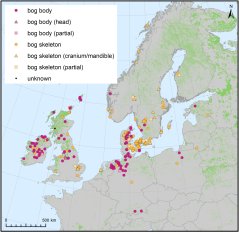
News
Bogs reveal millennia-old stories about violence and religion
Once, large parts of Europe were covered with peatlands. Only a fraction of those remain today. The bogs left are mostly part of protected nature reserves that are home to rare plant and animal species, and they are important as carbon stocks. But they tell fascinating stories about mankind, violence and religion as well. An international team of archaeologists and earth scientists have analysed hundreds of human remains found in Europe’s wetlands. This has led to new insights into our history.
From prehistory to early modern times, at least for 7,000 years, bogs were remarkably often used as a final resting place. Some bog bodies are iconic for being extremely well-preserved, such as Yde Girl. They offer a snapshot of life in the distant past. Most of those individuals were killed, probably as human sacrifices to a higher power. However, these well-preserved examples are only a fraction of what has been found.
“Although most bogs were reclaimed a long time ago, earth sciences in combination with archaeological research have made it possible to trace where they were situated, and what role they played in society at the time,” says Dr Roy van Beek of Wageningen University & Research.
Van Beek: “Literally thousands of people have met their end in bogs, only to be found again ages later during peat cutting. The well-preserved examples only tell a small part of this far larger story.”
Large-scale overview study
Van Beek and a team of Dutch, Swedish, and Estonian researchers set to undertake a large-scale inventarisation and analysis of bog bodies found in several European countries. Their research, published in the journal Antiquity, analysed over 1000 individuals from 266 sites. This led to a large-scale overview study for the first time.
Bog bodies can be divided into three main categories. Bog mummies, the famous bodies with preserved skin, soft tissue and hair. Bog skeletons, complete bodies of which only the bones have been preserved. And the partial remains of either bog mummies or skeletons. The different types are mainly the result of varying preservation conditions: some bogs are better suited to preserving human tissue, whilst others preserve bone better. As such, the distribution does not tell us much about past human behaviour.
“The study shows that the heavy emphasis on a small group of spectacular bog mummies has distorted our views,” said Van Beek. “All three categories yield precious information, and by combining them a whole new picture emerges.”
Trends over time and potential motives

The study reveals that the three kinds of bog bodies are part of millennia-long traditions. A first striking concentration of finds from 5000 BC is seen in southern Scandinavia. After that bog bodies gradually appear in other parts of northern Europe as well. The youngest finds show that the traditions continued into the Middle Ages and even early modern times.
Many finds indicate evidence of violence. Those bodies were likely intentionally left in bogs. They could be ritualistic sacrifices, executed criminals, or victims of crime. Archaeologically, it is often hard to distinguish between these motives. There also are indications for accidental deaths in bogs, as well as suicides.
Bogs as hotspots
Some areas were hotspots for bog bodies: wetlands where the remains of multiple people have been found. In Scandinavia, for example, there are cases where several victims of warfare were left in a bog at the same time. Other swamps were used time and again. In those cases the human remains were often accompanied by objects, probably as ritual offerings.
All in all, the new picture that emerges is one of age-old traditions, telling multiple stories about human themes like violence and religion. This makes bogs important not only because of their natural values, but also as an extraordinary archive of our past.